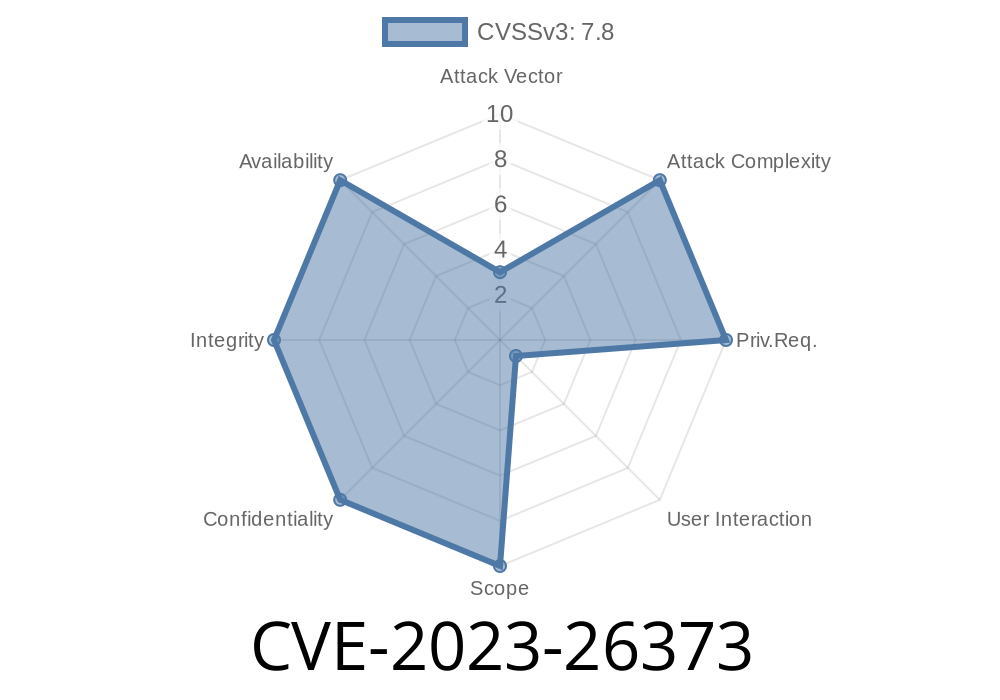A recently discovered security vulnerability, CVE-2023-26373, affects Adobe Dimension version 3.4.8 (and earlier) and poses a significant risk to its users. This post will delve into the details of this vulnerability, outline the potential risks, and provide recommended solutions to mitigate the threat. It's essential for users of Adobe Dimension to be aware of this issue and take the necessary precautions to secure their systems.
Background
Adobe Dimension is a 3D rendering and design software that allows users to create photorealistic images, interactive environments, and more. It is widely used by professionals and amateurs alike to create stunning visual content.
The vulnerability in question, CVE-2023-26373, is classified as an out-of-bounds write vulnerability. It can lead to arbitrary code execution in the context of the current user, which could have severe consequences for a user's system and data. This is especially concerning since it only requires user interaction in the form of opening a malicious file for the vulnerability to be exploited.
Technical Details
The out-of-bounds write vulnerability occurs when the software writes data outside the allocated buffer, resulting in memory corruption. An attacker can exploit this memory corruption by crafting a malicious file that, when opened by a victim, triggers arbitrary code execution.
Here is a code snippet that simulates the exploit
#include <stdio.h>
#include <string.h>
#define BUFFER_SIZE 10
void vulnerable_function(char *input) {
char buffer[BUFFER_SIZE];
strcpy(buffer, input); // Vulnerable function call – may write outside of buffer boundaries
printf("Buffer Content: %s\n", buffer);
}
int main(int argc, char *argv[]) {
if (argc < 2) {
printf("Usage: %s <input_string>\n", argv[]);
return 1;
}
vulnerable_function(argv[1]);
return ;
}
When this code is compiled and run with user-provided input, the input string may overflow the "buffer" memory area if it exceeds a specific length. This can cause memory corruption and potentially lead to arbitrary code execution.
For more technical details about this specific vulnerability, you may refer to the original security advisory here.
Exploit Details
To successfully exploit CVE-2023-26373, an attacker must first craft a file that is designed to take advantage of the out-of-bounds write vulnerability. Once this malicious file has been created, it must then be delivered to the target victim. This could take the form of a phishing email, a malicious download, or even a file payload delivered through social engineering.
Once the malicious file has been delivered and opened by the victim, the payload will execute in the context of the current user. Depending on the privileges of the user, this may allow the attacker to access sensitive data, compromise other systems or applications, and more.
Mitigation and Recommendations
To protect yourself from this vulnerability and other potential risks, it is crucial to follow several guidelines:
1. Keep your software up-to-date. Adobe has likely released a fix for this issue in a newer version, so ensure you're using the most recent version of Adobe Dimension available.
2. Be cautious when opening files from unknown sources. If you're unsure about a file's origin or purpose, don't open it without verifying its legitimacy first.
3. Use security software to help detect and prevent threats. Anti-malware and antivirus software can provide an extra layer of protection against malicious files and other threats.
By following these recommendations, you can minimize your risk of falling victim to the CVE-2023-26373 vulnerability or other potential threats.
Conclusion
CVE-2023-26373 is a serious vulnerability affecting Adobe Dimension version 3.4.8 (and earlier) users that can lead to arbitrary code execution. It is crucial for users to be aware of this threat and to take the necessary steps to mitigate the risk this vulnerability poses to their systems and data. Stay vigilant regarding the files you open, keep your software updated, and utilize security tools to protect yourself against this and other potential risks.
Timeline
Published on: 04/12/2023 20:15:00 UTC
